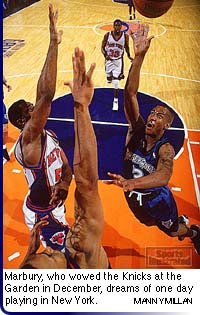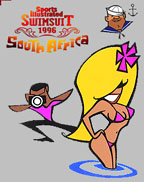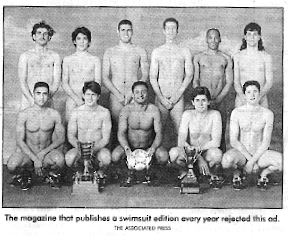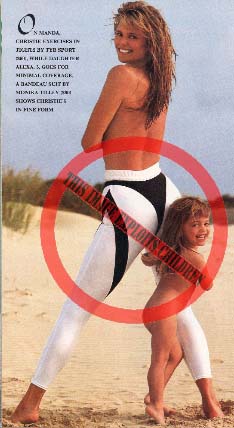| |
Linnea Smith
by Patricia Barrera
Continued from Previous
Page
In her brochures "What SPORTS are ILLUSTRATED?,"
and "Fans Call Foul on Sexism Illustrated," Smith refutes
SI's claim that their swimsuit issue is an innocent profile of the
latest styles in swimwear. Photos depict models' bodies so contorted it
is impossible to even see the outfits they are wearing. Part of the formula
is to include suits with maxium exposure, impossible to swim in or even
appear in on most beaches.
 
Left and Center: Contrast SIsi's depictions
of male athletes with their portrayal of women. Below: (Associated
Press photo.) The magazine that publishes a swimsuit
edition every year rejected this ad.

Smith
compared these crawling, twisting, dancing women with the male athletes
SI features in other issues. The differences were glaring. The men
are shown in strong, aggressive actions, competing hard against themselves
and their equally skilled peers in tests of skill and strength. Looking
at the men one thinks about their intelligence, determination, and power;
looking at the passive women with come hither looks and preorgasmic expressions
one thinks about their bodies, and their sexual appeal.
Thus, it made
sense that SI should reject an advertisement for Adidas sports shoes
featuring the Canadian Soccer League team nude except for the trophies
covering their genitals. It appears SI believes only women should
be stripped bare for inspection and approval.
In response
to this obvious double standard, Smith developed a brochure featuring the
now famous Adidas advertisement, and quotes from various commentators
deriding this decision Why
Does Sports Illustrated say Yes To This But No To
This"). She writes, "The same magazine that says readers
find the annual swimsuit issue to be ' . . . tasteful, informative and
entertaining' is now saying they canceled the Adidas ad because they '
. . . just didn't feel it was appropriate.'" B.J. Del Conte, who bills
himself as Canada's premier sports broadcaster summed it up best when he
said, " . . . Sports Illustrated's self-ascension to the moral
high ground is laughably pathetic."
SI
took an even bigger step down the road of social irresponsibility by depicting
young children naked and in sexually charged scenarios. Unlike their firm
stance against the Adidas men's soccer team ad, SI had no qualms
about presenting children in this manner. The 1986 swimsuit issue shows
a woman wearing a thong bikini arching her buttocks against a showerhead--and
directly into the face of a grade school boy. Their 1989 issue posed topless
supermodel Christie Brinkley with her naked three-year-old daughter.

Sports Illustrated
25th Swimsuit Issue
|
Sexual
harassment is now being reported on the grade school level. One out of
every four girls in this country is sexually abused by the time she is
eighteen. At the same time there is an organized movement to lower, if
not eliminate, the age of consent to sexual intercourse and access to children
by adult males. In that contextSI, by having placed children in
sexually charged situations with adults, has contributed to lowering the
prohibition against children as sexual targets and fueled pedophilia .
With evidence
in hand, Smith called for a boycott against the swimsuit issue that was
heard around the world. At Smith's urging, activists across the country
moved into action. The
Media Action Alliance in Minnesota drew up a list of the names
and addresses of every major advertiser
in the swimsuit issue, and organized letter writing parties; Media
Watch in California distributed postcards addressed to SI protesting
the swimsuit issue; people from as far away as Australia contacted Smith
for information on the boycott.
No longer
could SI count on an uncontested release of their heavily promoted
swimsuit issue. Smith had succeeded in reframing public understanding of
the SI swimsuit issue as a matter of social concern and people were
listening.
Actually,
the swimsuit issue had always been contested,
by individual women who hid the issue behind other magazines at the supermarket,
or threw it out when it was mailed to their homes. There were organized
protest as well, like the continuing annual picket in front of the Time-Life
building organized by Men
Against Pornography and Women Against Pornography (WAP).
According
to WAP, however, their annual protests were too often ignored by mainstream
media. Then Smith rallied to their side, sending
letters and her brochures to SI advertisers. Says member Cecilia
Blewer, "Linnea was successful in articulating to the media and to
the advertisers the injustice and harm imbedded in the swimsuit issue"
(WAP Newsreport, Summer 1993, p. 6).
This harmful
depiction of children along with SI's sexist discrimination fueled
worldwide media and public scrutiny. Activists across the country, including
Smith, moved into action and called for a boycott of the swimsuit issue.
The Media Action Alliance in Minnesota drew up a list of the names and
addresses of every major advertiser in the swimsuit issue, and organized
letter writing parties; MediaWatch in California distributed post cards
addressed to SI protesting the swimsuit issue; people from as far
away as Australia contacted smith for information on the boycott. For years,
people had been protesting the swimsuit issue, individually by hiding the
issue behind other magazines at the supermarket or by throwing it out when
it arrived in the mail and through organized protests like the annual picket
in front of the Time-Life building organized by Men Against Pornography
(MAP) and Women Against Pornography (WAP). Now, people are listening. Says
WAP member Cecilia Blewer, "Linnea was successful in articulating
to the media and to the advertisers the injustice and harm imbedded in
the swimsuit issue." (WAP Newsreport, Summer 1993, p. 6)
SI
representatives tried to downplay the effects of these efforts, but what
could they say when Korean car maker Hyundai Motors made the announcement
they were pulling their ads out of the issue? Certainly this was a sign
of things to come. Even though Hyundai was the only company to make a public
statement about their decision, and credit Smith and her work as a reason,
"it appears that other advertisers used their position to exact changes
in the swimsuit issue while others quietly dropped out altogether."
(Blewer, WAP Newsreport, Summer 1993, p. 6).
The children
were removed from Sports Illustrated's swimsuit issue in 1993 and
are still gone today. While the content remains the same, the swimsuits
and poses are not as explicit as they used to be. Is it only a matter of
time before the issue disappears altogether? Says Smith, "I don't
think the swimsuit issue is going to be tolerated. I think we're going
to look back on this and wince the way we did with separate drinking fountains."
(from The News and Observer Feb. 11, 1993.)
Smith's brochures
are definitely powerful enough resources to make that vision a reality.
They are impressive in the ease in which they can be studied, and the breadth
of information they contain. They stand as a challenge to all public definitions
and expressions of women, our bodies, and our sexuality. They are a much
needed interruption of the violent corruption of human sexuality that the
pornography industry --and its imitators-- pump out each
day, in each city, in every country in the world.
There is no
telling what these brochures can accomplish, once they are released worldwide
into the hands of the Web audience. But Smith already sees some changes
right here at home. In an interview with The New York Times she
said, "...In my daughter's junior high, more girls went out for the
basketball team than the cheerleading squad. I think that this idea of
dehumanizing and objectifying women--in sports and beyond sports--
is going by the wayside." (January 23, 1993, p. Y34). Change can
happen, but we all have to do our part. According to Mary Pipher, author
of the book Reviving Ophelia, "Cultural change is one person
after another doing the right thing. It's just that simple. The only way
that cultures change is when people do things that take energy and courage
and kindness, and everybody is capable of cultural change." end
Linnea's
Letter to the American Football Coaches Association Members and the
Board of Trustees callingon the AFCAA to disaffiliate with Playboy and
other pornographic magazines.
Playboy Magazine's Letter
Threatening to Sue Linnea Smith
Linnea's Letter
to Carolina Union about Nadine Strossen
*cover letter *Gary
Cole
Letter
to advertiser and response to Playboy publisher: Complete
version of a letter Linnea Smith wrote to advertisers in Playboy
magazine and response to Playboy publisher (July, 1995).
athletes

|
|


